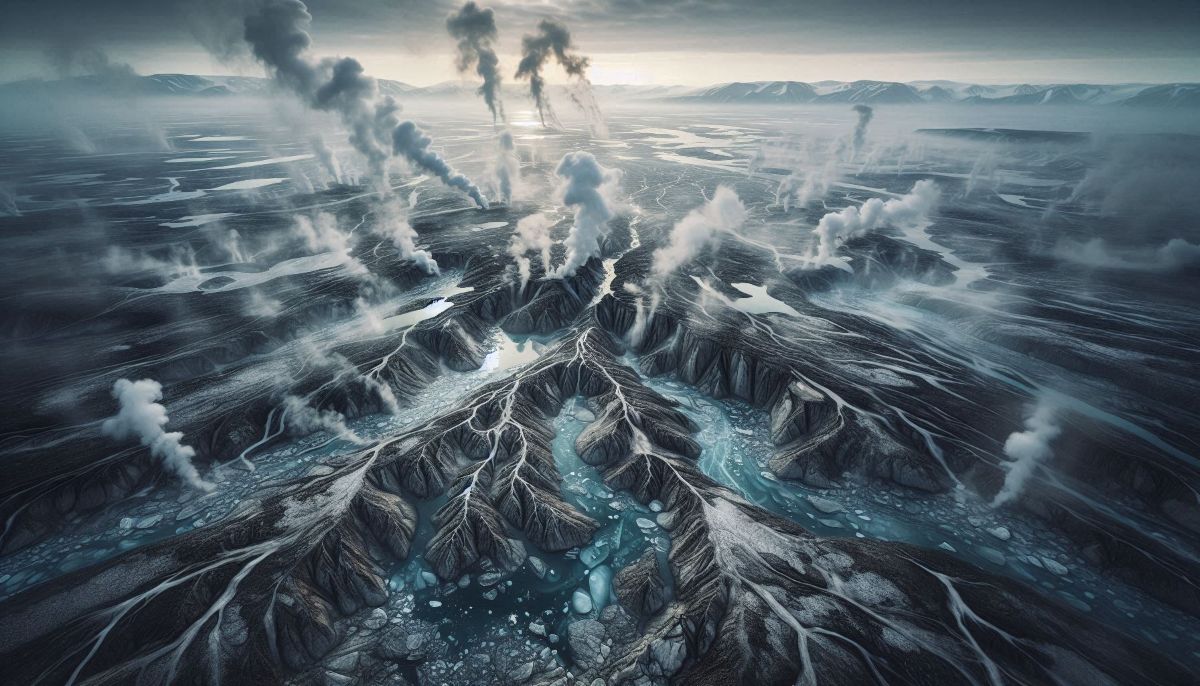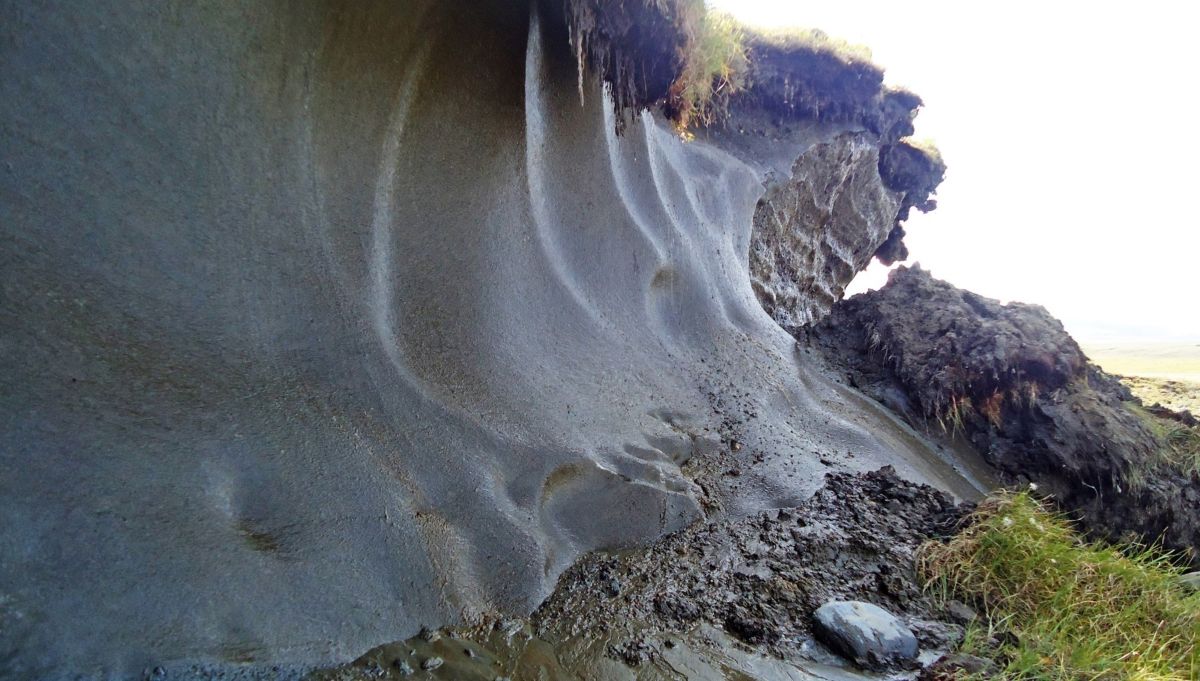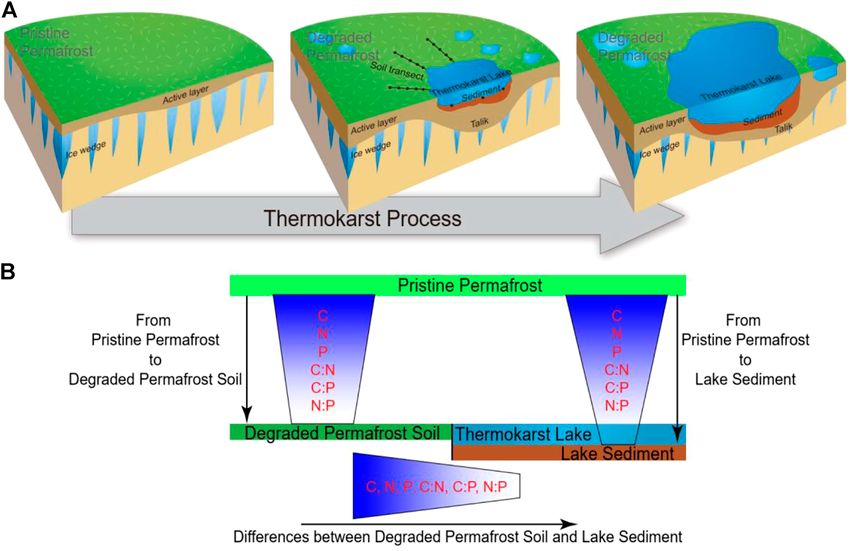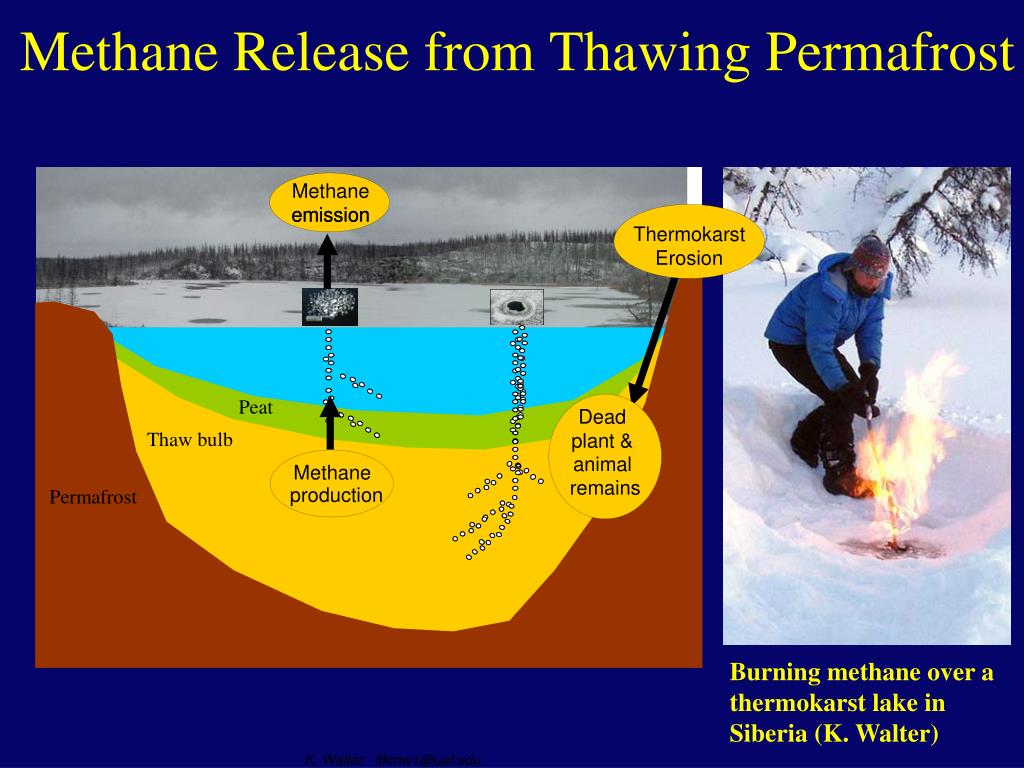
Watch short for this article (5 slides)
The Arctic's Unfolding Climate Bomb: Understanding Permafrost Thaw and its Global Consequences
Beneath the vast, treeless landscapes of the Arctic and the soaring peaks of high mountains lies a hidden world of frozen ground known as permafrost. This ancient layer, defined as earth material remaining at or below 0°C (32°F) for at least two consecutive years, acts as a giant subterranean freezer, locking away vast quantities of organic matter, greenhouse gases, and even long-dormant microbes. However, accelerated warming, particularly pronounced in polar regions, is causing this frozen foundation to thaw at an unprecedented rate. This thawing is not just reshaping Arctic ecosystems and threatening infrastructure; it's unlocking a potential climate feedback loop that could significantly amplify global warming, making permafrost thaw one of the most critical and concerning aspects of the climate crisis.

What Exactly is Permafrost and Why Does it Matter?
Permafrost underlies nearly a quarter of the Northern Hemisphere's land area, including large parts of Alaska, Canada, Siberia, Greenland, and high-altitude regions globally. It can range in thickness from less than a meter to over 1,500 meters (nearly 5,000 feet) and varies in composition from solid rock to soils rich in ice and organic material.
- Formation: Formed during past ice ages and maintained by cold climates, permafrost contains vast stores of organic carbon accumulated over millennia from dead plants and animals that only partially decomposed due to the extreme cold.
- The Active Layer: The uppermost layer of ground in permafrost regions, known as the active layer, thaws during the summer and refreezes in the winter. The permafrost lies beneath this layer. Climate change is causing this active layer to deepen, thawing previously permanently frozen ground.
- The Carbon Reservoir: The amount of carbon locked within permafrost soils is staggering. Current estimates suggest it holds approximately **1,400 to 1,600 billion metric tons (Gigatons - Gt) of organic carbon**. This is roughly **twice** the amount of carbon currently present in Earth's atmosphere and nearly three times the amount stored in all the world's forests combined. (National Snow and Ice Data Center - Permafrost and Carbon). It represents a massive, climate-sensitive reservoir of potential greenhouse gases.
The Great Thaw: Driven by Accelerated Arctic Warming

While the entire planet is warming due to human-caused greenhouse gas emissions, the Arctic is warming at **two to four times the global average rate**, a phenomenon known as **Arctic Amplification**. This rapid warming is the primary driver of permafrost thaw.
- Causes of Arctic Amplification: Primarily driven by the loss of reflective sea ice and snow cover. As ice melts, darker ocean or land surfaces are exposed, absorbing more solar radiation, which leads to further warming and more melting (an ice-albedo feedback loop). Atmospheric and oceanic heat transport changes also play a role.
- Direct Impact: Rising air temperatures directly warm the ground surface, increasing the depth of summer thaw and gradually warming the deeper permafrost layers over time.
Consequences of the Thaw: A Cascade of Impacts

The thawing of permafrost triggers a series of interconnected environmental, infrastructural, and climatic consequences:
1. The Carbon Bomb Feedback Loop: Releasing Ancient Greenhouse Gases
This is the most globally significant consequence. As the frozen organic matter within permafrost thaws, it becomes available for decomposition by microbes (bacteria and fungi).
- Aerobic Decomposition (With Oxygen): In drier, well-drained thawed soils where oxygen is present, microbes break down organic matter primarily releasing **Carbon Dioxide (CO₂) **.
- Anaerobic Decomposition (Without Oxygen): In waterlogged, oxygen-poor thawed areas (like newly formed wetlands or lake bottoms), different types of microbes (methanogens) take over, breaking down organic matter and releasing **Methane (CH₄)**.
- The Feedback Mechanism: Both CO₂ and CH₄ are potent greenhouse gases. Their release from thawing permafrost adds to the atmospheric concentration of these gases, trapping more heat, further accelerating global warming, which in turn causes more permafrost to thaw, releasing even more greenhouse gases. This creates a dangerous **positive feedback loop** that could become self-sustaining if critical temperature thresholds are crossed.
- Abrupt Thaw (Thermokarst): Beyond gradual active layer deepening, thawing ice-rich permafrost can lead to abrupt ground collapse, forming features like thermokarst lakes and wetlands. These processes can rapidly expose large amounts of deep, previously frozen organic carbon to decomposition, potentially releasing greenhouse gases much faster than gradual thaw alone. (NOAA Arctic Report Card often discusses permafrost thaw).
2. Infrastructure Collapse and Coastal Erosion
Frozen ground provides a stable foundation for structures. As it thaws, it loses its structural integrity, leading to significant problems, particularly in the Arctic where many communities and industrial facilities are built on permafrost:
- Damage to Buildings and Roads: Thawing causes the ground to subside unevenly, leading to cracked foundations, buckling roads and railways, damaged airport runways, and leaning buildings. Maintaining infrastructure in permafrost regions is becoming increasingly costly and challenging.
- Pipeline Risks: Oil and gas pipelines built on permafrost, like the Trans-Alaska Pipeline System, face risks from ground instability, requiring extensive monitoring and engineering solutions.
- Coastal Erosion: Permafrost acts like cement holding coastal bluffs together. As it thaws, combined with reduced sea ice protection allowing for stronger wave action, coastlines can erode dramatically—sometimes tens of meters per year—threatening coastal communities and infrastructure. Subsea permafrost thaw can also release methane directly into the ocean and atmosphere.
3. Hydrological Changes
Thawing permafrost alters the movement of water across the landscape:
- Formation and Drainage of Lakes: Thawing ground ice can lead to the formation of new lakes (thermokarst lakes). Conversely, existing lakes can sometimes drain suddenly if thawing creates new underground drainage pathways.
- Altered River Flows: Changes in ground stability and water pathways can affect river discharge patterns and water chemistry.
4. Resurfacing Ancient Microbes: A Potential but Uncertain Risk
Permafrost has preserved microbes (bacteria, viruses) for tens or even hundreds of thousands of years. As the ground thaws, these dormant organisms could potentially be reactivated.
- The Concern: The possibility exists that ancient pathogens, to which modern humans and animals have no immunity, could re-emerge. Cases like anthrax outbreaks in Siberia linked to thawing reindeer carcasses highlight this potential pathway.
- Current Scientific View: While a theoretical risk, the actual likelihood of widespread pandemics caused by ancient permafrost microbes is generally considered low by many experts, but it remains an area of active research and monitoring. Factors include pathogen survival rates after thawing, infectivity, and the presence of suitable hosts. (American Society for Microbiology discussion). Sensationalism should be avoided, but the potential cannot be entirely dismissed.
5. Impacts on Ecosystems and Indigenous Communities
- Vegetation Shifts: Thawing allows shrubs and trees to expand into former tundra regions, altering habitats.
- Wildlife Impacts: Changes in vegetation, hydrology, and landscape stability affect wildlife migration patterns, breeding grounds, and food availability (e.g., for caribou/reindeer).
- Indigenous Livelihoods: Arctic Indigenous communities rely heavily on the stability of the land and ecosystems for traditional hunting, fishing, trapping, and travel. Thawing permafrost disrupts these practices, impacts food security, damages cultural sites, and forces community relocation in some cases.
Comparing the Greenhouse Gases: CO₂ vs. Methane from Permafrost

Understanding the different impacts of CO₂ and CH₄ is crucial:
| Gas | Primary Source (Permafrost Thaw) | Global Warming Potential (GWP) - AR6* | Approx. Atmospheric Lifespan | Key Impact Characteristic |
|---|---|---|---|---|
| Carbon Dioxide (CO₂) | Aerobic decomposition of organic matter | 1 (baseline) | Variable; centuries to millennia (a portion remains for a very long time) | Primary driver of long-term, cumulative warming. |
| Methane (CH₄) | Anaerobic decomposition of organic matter (in wet conditions) | ~80-83 times CO₂ over 20 years ~27-30 times CO₂ over 100 years |
~12 years | Extremely potent warming effect in the short term after release, significantly accelerating near-term warming. |
*GWP values based on IPCC Sixth Assessment Report (AR6), including climate-carbon feedbacks. Values can vary slightly depending on methodology.
The potent short-term warming effect of methane means that large CH₄ releases from thawing permafrost, especially from abrupt thaw events in wetlands and lakes, are a major concern for accelerating near-term climate change.
Can We Stop the Thaw? Mitigation and Adaptation Realities
Slowing or stopping large-scale permafrost thaw presents immense challenges:
- Reduce Global Carbon Emissions (The Most Effective Strategy): The *only* viable way to limit widespread permafrost thaw globally is to aggressively reduce human-caused greenhouse gas emissions (CO₂, CH₄, N₂O) by transitioning away from fossil fuels and improving land use practices. Limiting global warming to the Paris Agreement targets (well below 2°C, aiming for 1.5°C) is critical to keep vast amounts of permafrost carbon locked away.
- Protecting Natural Carbon Sinks: While conserving forests and wetlands doesn't directly stop thaw caused by global temperature rise, these ecosystems absorb atmospheric CO₂, helping to mitigate the overall warming that drives thaw.
- Geoengineering and Local Interventions (Limited Scope/High Risk): Various ideas have been proposed, but none are considered feasible or safe for large-scale application:
- Surface Modifications: Using reflective materials to reduce heat absorption (impractical on vast scales).
- Reintroducing Large Herbivores: Some studies suggest trampling by animals like bison or reindeer can compact snow, allowing deeper cold penetration in winter (ecological impacts and scalability are major questions).
- Localized Cooling: Engineering techniques to actively cool the ground under critical infrastructure (extremely expensive, energy-intensive, only protects small areas).
- These approaches are largely theoretical, experimental, or only applicable at hyper-local scales (like protecting a specific building) and do not address the root cause.
- Adaptation: For communities and infrastructure already impacted, adaptation strategies are necessary. This includes developing new building techniques for thawing ground, relocating critical infrastructure or entire communities where feasible, enhancing monitoring systems, and adjusting resource management practices.
Future Projections: A Ticking Clock
Climate models project significant permafrost loss throughout the 21st century, with the extent depending heavily on future emissions pathways. Under high-emissions scenarios, estimates suggest the near-surface permafrost area could shrink by **up to 70% or even 90% by 2100**. Even under lower emissions scenarios consistent with Paris Agreement goals, substantial thaw and associated greenhouse gas release are still expected. The potential for permafrost carbon release to act as a major climate feedback, potentially pushing the Earth system past critical tipping points, remains a profound concern within the scientific community.
Conclusion: Heeding the Arctic's Warning
The thawing of Earth's permafrost is far more than a localized Arctic issue; it is a global climate emergency unfolding in slow motion but with accelerating consequences. The release of vast stores of ancient carbon as CO₂ and potent methane threatens to create a dangerous feedback loop, amplifying the warming caused by human activities. Coupled with devastating impacts on Arctic infrastructure, ecosystems, and Indigenous communities, the thawing permafrost sends an urgent warning. While adaptation measures are necessary for affected regions, the only effective way to limit the widespread thaw and its global repercussions is through immediate, sustained, and ambitious global action to reduce greenhouse gas emissions and stabilize the climate.